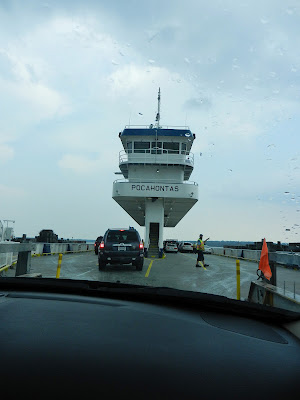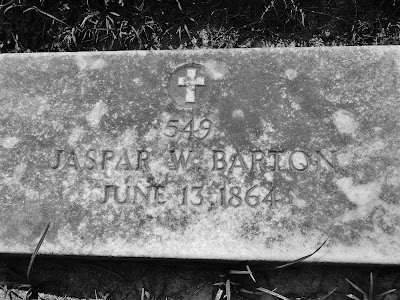Well, I wasn't going to give you a blow-by-blow account of the rest of our trip to Virginia, but then I thought to myself, Self, this is your journal and you know you will forget unless you write about it.
So here I is.
We landed in Norfolk and visited the Botanical Gardens the first day. The next morning, we drove up to Richmond, where we would spend the next three days. On the way to Richmond, we checked out the Naval Museum and Yorktown.
The Naval Museum in Norfolk was more interesting than I expected. It is contained in a larger building that houses Nauticus, a maritime science museum geared towards children. The Naval Museum is free; Nauticus
is not.
The museum covers the history of the U.S. Navy from its inception in the early days of the Revolutionary War to the present. There are many actual relics of war...
...as well as models of battleships. The detail is quite excruciating. And if you're lucky, like me, you will keep bumping into a cute guy wearing a Coastguard hat!
As we walked around the museum, we had exchanged a few words with another couple. The lady told us that her grandfather made this cigar holder. He had served on the Battleship Wisconsin, which is berthed outside Nauticus.
And here it is. We were going to look around the ship but were accosted on the way in and told that we needed to pay the Nauticus entrance fee in order to board.
We declined.
But it is a grand ship. It is one of the largest and last battleships ever built by the U.S. Navy.
The biggest flag I have ever seen hangs in the foyer.
On to Yorktown, on the Chesapeake Bay, site of the last battle of the Revolutionary War. Here, General Lord Cornwallis surrendered to American (led by George Washington) and French (led by Comte de Rochambeau) forces on October 19th, 1781. There is an interesting account of the battle
here. Washington pulled a sneaky trick on the British, but it is unlikely that he would have won the decisive battle if it were not for the French. I told Jeff he needs to be nicer to the French.
Our walking tour guide was inspired and passionate. He added vivid details to the battle story so that even I was intrigued. We found that most of the guides are history majors who really know their topics.
We walked on the very ground that British troops sweated and fought upon in the fall of 1781. It is an eerie thing, imagining those men, so many years ago, fighting and dying upon the same redoubt that I lay down and rested on this humid day in June.
There is a visitor's centre in the park and it houses General Washington's tent. The photo is rubbish, but I felt rather reverent as I stood before the tent.
After visiting the Yorktown National Cemetery, where many of the photos in the last post were taken, we moseyed on over to the town. It was late afternoon and we were starving, so we found a modest little restaurant and filled our tummies. I will forbear from telling you about the almost-naked old guy who came into the restaurant for a soda and stood at the counter flexing his tanned muscles and then went outside and stood on the beach and posed some more. It was disturbing.
We hung around for a few hours because we saw some posters for a concert that was planned for the evening. A good time was had by all. Jeff and I even danced a bit. We shared a bench with a sweet older couple. The man scared me a little because his dyed mustache and eyebrows reminded me of fuzzy caterpillars.
Behold, the Cupid Shuffle.
A hip-hop line dance.
Yes, you read me right. It was hard to catch the hip-hop intonation as performed by the band, but hip-hop it was. I wondered why a few older African American ladies were doing a country line dance! That explains it.
We drove down to Jamestown from Richmond the next day. Jamestown, across the peninsula from Yorktown and a little bit north, sits on the James River. It is the site of the first permanent settlement of Europeans in America. We watched glass blowers at work and I bought a nice little condiment jar.
I'm a sucker for glass.
The settlers established a glass factory so that they could export glass to Europe, as there was a greater demand for glass than their existing factories could supply.
We were in the middle of a heat wave, but the sky was threatening.
Excavation continues at Jamestown, searching for information about those first settlers.
Jeff wanted to join the dig.
This fort is where Pocahontas played as a child and was later taken hostage during Anglo-American hostilities and held for ransom. Her father, Chief Powhatan, refused to comply with the demands of the English and Pocahontas remained in the fort. A year later, she reportedly had an opportunity to speak to her father and she rebuked him for valuing her "less than old swords, pieces and axes" and chose to remain with the English. She later converted to Christianity and married John Rolfe. Nancy Reagan is among her descendants.
Jeff noticed that the hands on her statue are shiny, unlike the rest of her oxidized body.
We, too, brushed her hand as we passed by.
The threatened storm hit with a vengeance as we started towards the exit, so we took shelter.
It was a doozy.
I saw a sign that advertised the free ferry to Scotland.
We took it.
Why not? I said.
We find ferry trips to be quite boring.
How about you?
Jeff was very disappointed to find himself still on American soil, but there you have it.
Scotland, VA.
We soldiered on to Surry (the spelling bothers me) and found an excellent restaurant that provided us with a taste of Southern cooking.
Country ham, baked potato, and apple fritter for me.
What, you thought I would order broccoli when an apple fritter was offered?
Ha!
Jeff had country-fried chicken and hush-puppies.
I think I am in love. Hush puppies and I get along really well.
The next day found us in the Civil War battlefields of Spotslyvania, Fredricksburg, and Chancellorville. The highlight for Jeff was finding a record of his ancestor, Thomas Ward Osborne, who fought in some of these battles and went on to become a state senator.
This is the site of the sunken road in Fredricksburg, a particularly bad battle for the north. The Confederates had a strong position behind this wall on the sunken road and on the hill behind it. Wave after wave of Union soldiers was sent up the slope on December 13th, 1862, only to be shot down. When the next morning dawned, about 8,000 men lay dead or grievously wounded in front of the wall.
Chancellorville.
We had an excellent tour guide, but, to be honest, my mind was mush by this point.
Let me just say that the cannons on this side of the field were firing against those little tiny cannons that you can see in the distance.
The second-bloodiest day of the Civil War took place here on May 3rd, 1863.
And I'm not even sure who won.
Another awesome tour guide.
So, here's what I think.
You should go visit these historical sites.
You should take every walking tour for which you have time.
You should take a hankie.
And you should not go during a heat wave.





















































